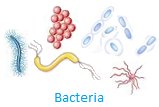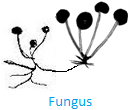Microbes and their Kinds
We will discuss here about microbes and their kinds. We can see many different kinds of living things around us but there are many other things that we cannot see.
There are millions of very tiny living things which are found everywhere. They are present in the air, in water, in the soil and even inside our body. They are so small that we cannot see them with our eyes and we can only see them through a microscope. They are known as microbes. Some microbes are useful to us while some are harmful. Some of the microbes cause diseases and they are known as germs.
There are four kinds of microbes. They are bacteria, protozoa, viruses and fungi.
(i) Bacteria: Bacteria are found everywhere
and they are the most abundant living things on the earth. They have different
shapes.
Harmful bacteria cause diseases such as typhoid and food poisoning. They also cause tooth decay. Useful bacteria help in the decay of dead plants and animals. These bacteria are used in making foods such as cheese, vinegar, yoghurt, etc. Some bacteria help animals in digesting food.
(ii) Protozoa: Some protozoa live in wet places and the others live in the bodies of plants and animals. They cause diseases like malaria and dysentery.
(iii) Viruses: Viruses are smaller than all other microbes (i.e. bacteria, protozoa, and fungi). They cause diseases like common cold, influenza, polio, mumps and measles.
(iv) Fungi: Fungi grow on dead and rotting things. They cause skin problems such as ringworm. The dandruff on our scalp is also caused by fungi. Some fungi are useful such as yeast is a fungus (singular) helps in making of bread and wine.
Bacteria, protozoa, viruses and fungi are microbes. Diseases causing microbes are called pathogens.
Useful microbes:
(i) Some bacteria change milk into curd
(i) Some bacteria help in decaying of dead plants and animals.
(i) Some bacteria digest roughage in animals
(i) Some bacteria produce vitamins in the human body.
From Microbes and their Kinds to HOME PAGE
Recent Articles
-
What Is Plasma? | Blood Plasma | Proteins | Nutrients | Cholesterol
Nov 07, 25 10:29 AM
Blood is a mobile fluid which is a connective tissue and is derived from the mesoderm like cell any other connective tissue. Colour of blood is reddish and that flows inside the blood vessels by means… -
Disorders of Respiratory System | Tuberculosis | Pleurisy | Emphysema
Oct 28, 25 11:39 PM
Tuberculosis is very common disease and is caused by a type of bacteria called Mycobacterium tuberculosis. This disease causes different trouble in the respiration and infection of several parts of th… -
Regulation of Respiration | Respiratory Centres | Inspiratory Area |
Oct 14, 25 12:13 AM
Respiratory Centre is the area that controls the rate of respiration and it is observed to be located in medulla oblongata and pons. Respiratory Centre has the following will dispersed components like… -
Explain Transport of Gases | External Respiration | Tissue Respiration
Oct 09, 25 11:35 PM
In humans gaseous exchange is completed in the following ways the steps are - External Respiration or Breathing - Breathing in false taking in of Oxygen and giving out of carbon dioxide in the body. M… -
Kind and Number of Teeth | Location of Teeth in Mouth | Care of Teeth
Sep 11, 25 12:52 AM
Kind and Number of Teeth









New! Comments
Have your say about what you just read! Leave me a comment in the box below.